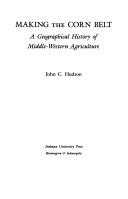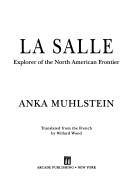| Listing 1 - 3 of 3 |
Sort by
|
Book
Year: 1994 Publisher: Washington (D.C.) : Smithsonian institution press,
Abstract | Keywords | Export | Availability | Bookmark
 Loading...
Loading...Choose an application
- Reference Manager
- EndNote
- RefWorks (Direct export to RefWorks)
Dikelocephalus --- Paleontology --- Animals, Fossil --- Mississippi River Valley.

ISBN: 0585233667 9780585233666 0253328322 9780253328328 Year: 1994 Publisher: Bloomington : Indiana University Press,
Abstract | Keywords | Export | Availability | Bookmark
 Loading...
Loading...Choose an application
- Reference Manager
- EndNote
- RefWorks (Direct export to RefWorks)
Stretching from the Rockies to the Appalachians, the Corn Belt is America's heartland. Making the Corn Belt traces the geographical and agricultural evolution of this region, whose agriculture is based on the tradition of feeding corn to meat animals, especially beef cattle and hogs. The use of corn as a feed grain emerged in the westward movement of Euro-American farming people from the Upland South to the Ohio Valley. In the five islands of fertile land west of the Appalachians - the Nashville Basin, Pennyroyal Plateau, Bluegrass, Miami Valley, and Virginia Military District - corn emerged as the best crop to feed livestock. Thus was the Corn Belt born. Migrants from the Five Islands took corn-livestock agriculture west to the Mississippi Valley, and by 1850 the core of today's Corn Belt was a cultural region developed by a segment of the population whose ancestry could be traced back to the Ohio Valley. Corn Belt agriculture, however, spread northward more slowly than it did westward, partly because of the patterns of migration established in the spread of the frontier. The Civil War demonstrated that, even though its agriculture was distinctive, the larger region was divided in social and political terms. John Hudson traces these regional-agricultural themes into the rapid technological changes of the 1930's. The introduction of soybeans at about this time helped shift parts of the Corn Belt from livestock feeding to cash-grain production. Some of these trends continue today in parts of the region, while other areas have specialized in cattle feeding as the meat-packing industry has shifted westward. Farm residents in the 1990's account for less than 2 percent of the national population. In the Middle West today, to be a "farm resident" no longer means what it once did: although nearly two-thirds of the men work primarily on the farm, nearly three-fourths of farm women are principally employed elsewhere. Many farmers have left the land and abandoned the "traditional" farm, but those who remain have been even more productive. The "typical" Corn Belt farm has disappeared, replaced by a small cluster of metal buildings surrounding a suburban tract home. John C. Hudson takes us to the heart of the Corn Belt and captures the essence of this most "American" region.
Corn --- Corn plant --- Indian corn --- Maize --- Zea mays --- Zea --- Middle West --- American Midwest --- Central States --- Central States Region --- Midwest --- Midwest States --- Midwestern States --- North Central Region --- North Central States --- Mississippi River Valley --- Northwest, Old --- Geography.

ISBN: 1559702192 Year: 1994 Publisher: New York : Arcade Publishing,
Abstract | Keywords | Export | Availability | Bookmark
 Loading...
Loading...Choose an application
- Reference Manager
- EndNote
- RefWorks (Direct export to RefWorks)
Explorers --- Explorers --- Explorateurs --- Explorateurs --- Biographies --- Biographies --- La Salle, Robert Cavelier, --- Canada --- Mississippi River Valley --- Canada --- Mississippi, Vallée du --- History --- Discovery and exploration --- French. --- Histoire --- Découverte et exploration --- Français
| Listing 1 - 3 of 3 |
Sort by
|

 Search
Search Feedback
Feedback About
About Help
Help News
News